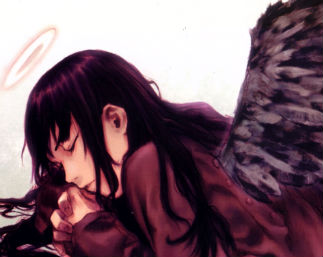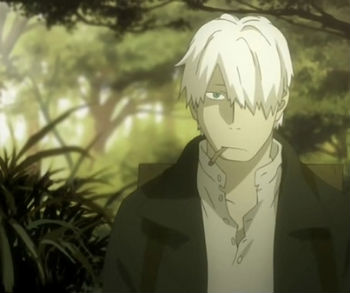

Quick Links:
Eight Quality 2000s Anime You Might Have Missed
Inspired by a similar post at Reverse Thieves, I present to you my list of anime that you might have missed during this fine decade, and if so, consider this a holy mandate of thou shalt watch them.
Haibane Renmei (2002) & Niea_7 (2000)
Haibane Renmei got a little attention on the fansub scene, thanks to Yoshitoshi Abe being that guy who did the character designs for Lain. The title collected dust for a while, then finally was released by Geneon in 2005, and by then, not too many people were talking about it. With a setting inspired by Hard Boiled Wonderland and the End of the World, a Haruki Murakami novel, Haibane Renmei is a story of discovery and emotional/spiritual growth centered around the angel-like haibane, who are "born" into this world with no knowledge of where they came from or how they got there. We learn with the newcomer, Rakka, how this new world works, and the circumstances under which a haibane is able to leave. Very highly recommended.
Yoshitoshi Abe also made a wacky little show in between Lain and Haibane, called Niea_7 (pronounced "nee-uh under seven"). The show made few waves, if any at all, and that's a shame. Like Haibane, it's a spiritual title, centering this time on the Buddhist core tenet of "everything changes," or as we know it, "shit happens." Niea is an alien, but she doesn't have an antenna like the other, higher-class aliens, so her peers label her as an "under 7," the lowest possible class. You wouldn't know it, though, because Niea's incurable optimism and sense of humor regularly overwhelm her roommate, Mayuko. A diametric opposite, Mayuko is a quiet and depressed cram school student. In addition to being about their daily lives, Niea_7 explores themes of racial stereotyping and integration, sentiment as a crippling force, and change as relief. Don't let its weirdness scare you away; it's definitely worth it.
Kino's Journey (2003)
Kino no Tabi: The Beautiful World didn't get a lot of buzz while airing, so far as I can recall. The ADV release in 2004 generated a good number of recommendations, though, especially on the Anime on DVD forums. Anyone asking for a slice of life recommendation is still bound to hear "Kino's Journey" in response, but as it's fairly difficult to explain the appeal of this show, I suspect that plenty of fans haven't managed to see it yet. This is a grave mistake, and not just because they're missing an amazing theme song (All the Way, by Mikuni Shimokawa).
Kino is a young girl who travels the world on her talking motorcycle, and periodically learns about a new country. She never stays in one place longer than three days, as in her words, it's enough time to figure them out — their problems, strengths, and quirks are readily visible to an outsider. The countries all symbolize a specific social ill or advantage that you might find in a more-complex society, i.e. modern countries are each some combination of these. Kino occasionally is tempted to stay longer, or decides right off the bat that sticking around isn't a great idea, and all of her visits reveal a sliver of her character to the audience. It's a neat show, so watch it!
Mushi-Shi (2005)
Mushi-Shi took me by surprise. I picked it up after an anime burn-out period; while looking for a recommendation for macabre or moral anime, someone threw it my way. I had actually never heard of it at that point, and I get the impression that few people talk about it.By the standard interpretation, mushi means "bug." The show's mushi aren't necessarily more important than insects are to the world, but they are more of a paranormal phenomenon — anything from simple life forms that interact with humanity by chance, to the very fabric of nature. Ginko is a man who can perceive and study these bugs. His occupation as mushi master (mushi-shi) is to help people who experience ill effects from interaction with the mushi. Much like Kino's Journey, Mushi-Shi's objective is to assemble a view of the natural world through Ginko's experiences, and to progressively learn about the man himself. Ginko is somewhat a tragic character, being that his tendency to attract mushi forces him to forego a long stay at any one place, but one gets the sense that he finds at least some aspects of his life fulfilling. Everything about this show is presented in a way that feels interesting and new, and it's difficult to not get drawn into the characters' lives.
Kaze no Yojimbo (2001)
This is an odd show, in the sense that it bears the name of Kurosawa's classic comedy in its title, but it's not a comedy. The show is a murder mystery which happens to borrow character personalities and style elements from its spiritual predecessor, Yojimbo. It had the looks of a dirt cheap production, and I suspect that critics are the only people who saw this show in the states.
George Kodama (not his real name, naturally) travels to the bohunk town of Kimujuku looking for clues explaining what happened to his brother, a soldier who boarded a train years prior and never returned. He's a pretty talented fighter, so he's able to work as a bodyguard (i.e. youjinbou) for the two competing gangs in town, while simultaneously stirring things up a bit between them. George acts out of his obsession to find the truth, and while he doesn't expressly invite chaos, innocent people get hurt. Kaze no Yojimbo is about confessing the sins of the past and putting a community back in balance. Its cheap look might be a turn-off for some, but I found the title as a whole engaging.
Boys Be... (2000)
This show went unlicensed for what seemed like an eternity. A few of us (me included) looked to a release from Singapore (published by Odex) in order to check it out. The Odex release was a bit sloppy on the English front, but the subtitles were leagues above bootleg quality, at least. Nevertheless, it was good news when Nozomi / Right Stuf picked up the license.
Boys Be... is a story of teenage romances from the male perspective. It follows Kyoichi the artist, Makoto the nerd, and Yoshihiko the jock, through their misadventures at dealing with the female element. Aside from Kyoichi channeling Shinji Ikari a couple times, the relationships presented are refreshingly normal and harmless (to the audience). That's not to say the characters don't have their share of trials, jealousy, and soul searching, but all of humanity doesn't get sucked inside a big amoebic blob of former humans. Did I mention the soundtrack's really good?
Tokyo Godfathers (2003)
If the words "Satoshi Kon" aren't enough reason for you to see this movie, there might not be much I can do for you. Still, if there is a Satoshi Kon movie that people might have skipped by accident, it's this one, and it's as worthy of a viewing as any of the others.
Partly adapted from an old movie, 3 Godfathers, the film shows us three homeless people: a tranny, teenaged girl, and a former salaryman, as they find a newborn child in a garbage heap. It's a tale of redemption, in which we see the baby bring each of the fallen in contact with their former lives, often in hilarious and unpredictable ways. It's a feel-good film for anybody who's ever felt lost or trapped in a life they didn't deserve.The Girl Who Leapt Through Time
Now, this title is pretty well known, as anything with Yoshiyuki Sadamoto character designs is bound to draw some eyes; however, it has come to my attention that there are people out there who have not seen this movie. This is, frankly, unacceptable.
Adapted from the novel of the same name, Toki wo Kakeru Shoujo (shorthand: tokikake) is a visual feast and a fascinating story about how time operates on human lives. It's the story of Makoto, a teenaged girl who makes a bad day both better and worse by discovering a device that lets her jump (literally) back in time. It's a story that, like several before it, aims to deflate the romantic sentiment of "if I had it to do all over again...," while throwing some big picture ideas like the rise and fall of civilizations into the mix. Add to that a blend of gorgeous still-life photography and animated Van Gogh, and you have one of the finest films to come out of Japan yet.
So what are you waiting for?




